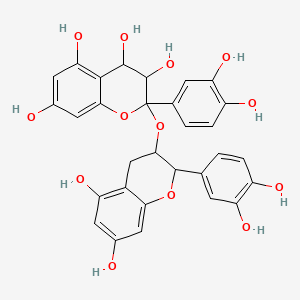| ImmunCR Id : | ICR112 |
| Chemical Name : | Procyanidin |
| Plant Source : | Malus domestica |
| Nutraceutical information : | Edible, High content in apple, grapes, nuts, grains, cranberry, red wine, cocoa, tea. |
| Mode of administration : | --- |

| Immunomodulatory mechanism : | Antioxidant (inhibits ROS, RNS, hydroxyl reactive species, inos, upregulates IL-12, Nrf2/ARE signaling pathway, ARE-mediated transcription, Nrf2 expression, GSH, HO-1 (heme oxygenase-1), GSH-Px, downregulates MAPK pathway); Anti-cancer (upregulates NF-kb, MAPK, p13k/Akt pathway, Akt/mtor pathway signaling, caspase-3, Bcl-2, downregulates Notch1 pathway, Bax, p53, IGFBP-3 (insulin like growth factor binding protein-3) enzymes, EGFR/VEGF/MMP9, inhibits COX-2, PGE2); Anti-inflammatory (downregulates p38, ERK, phosphorylation of JNK, TNF-ꭤ, malondialdehyde, IL-6, CD80, CD86, MHC class II, inhibits ERK1/2, ikkb enzymes, MAPK, NF-κb pathways, upregulates SOD (superoxide dismutase), Nrf2) |
| Description : | Procyanidin is a homo-oligomeric proanthocyanodin polyphenolic compound comprising flavan-3-ol units containing catechin and epicatechin. It has a poor oral bioavailability and absorption because of the interaction with other foods and gastric ph. |
| IUPAC Name | 2-(3,4-dihydroxyphenyl)-2-[[2-(3,4-dihydroxyphenyl)-5,7-dihydroxy-3,4-dihydro-2H-chromen-3-yl]oxy]-3,4-dihydrochromene-3,4,5,7-tetrol |
| SMILES | C1C(C(OC2=CC(=CC(=C21)O)O)C3=CC(=C(C=C3)O)O)OC4(C(C(C5=C(C=C(C=C5O4)O)O)O)O)C6=CC(=C(C=C6)O)O |
| Formula | C30H26O13 |
| InchiKey | HGVVOUNEGQIPMS-UHFFFAOYSA-N |
| Kingdom | Organic compounds |
| Superclass | Phenylpropanoids and polyketides |
| Class | Flavonoids |
| Subclass | Flavans |
| LogP | 3.588 |
| Molecular weight | 594.52 |
| Hydrogen Bond Acceptor | 13 |
| Hydrogen Bond Donor | 10 |
| Polar surface area | 234.945 |
| No. of rotatable bonds | 4 |
| Number of Aromatic Rings | 4 |
| Number of rings | 6 |
| Absorption level | Very low |
| Solubility level | Very Soluble |
| Blood Brain Barrier | Undefined |
| Plasma protein binding | Non-Binder |
| CYP2D6 inhibition | Inhibitor |